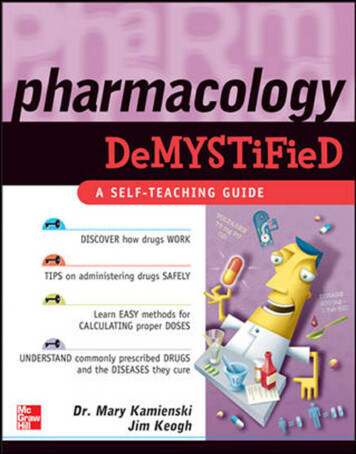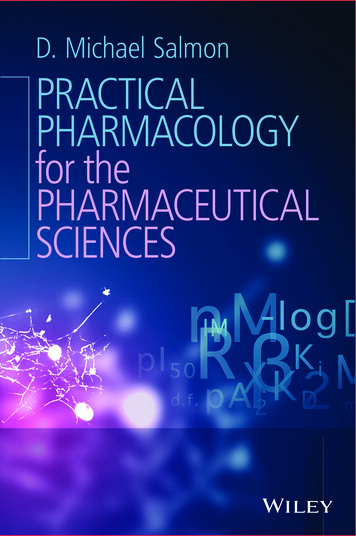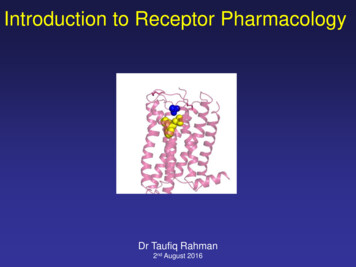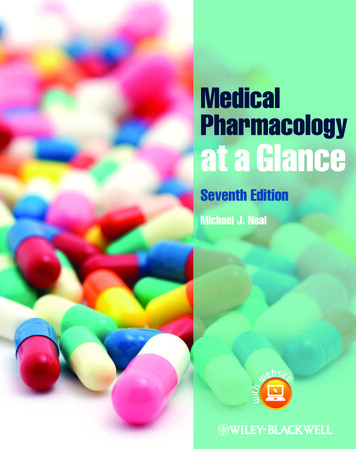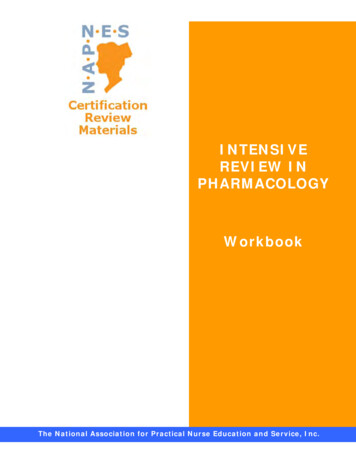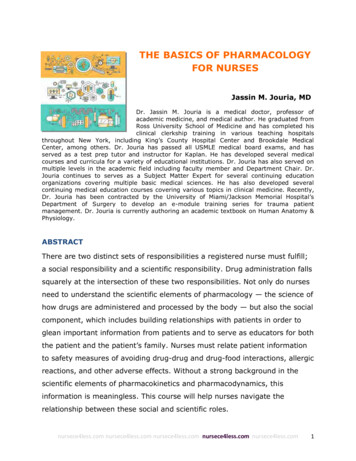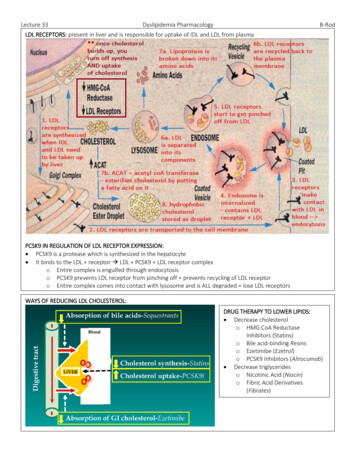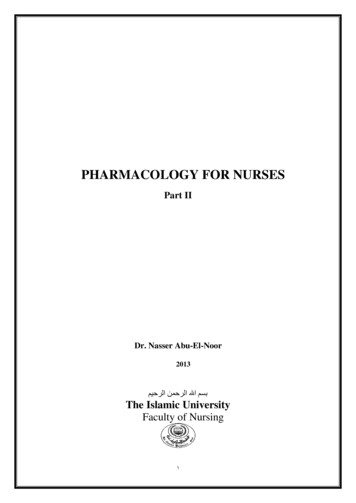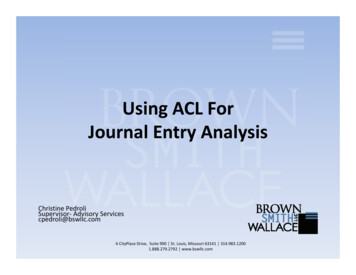
Transcription
BOLK’S COMPANIONSFOR THE STUDY OF MEDICINEPharmacologySelected Topicsfrom a PhenomenologicalPoint of ViewChrista van Tellingen MD We wouldbe interestedto hear youropinion about this publication.You can let usknow at http://www.kingfishergroup.nl/questionnaire/
About the Louis Bolk InstituteThe Louis Bolk Institute has conducted scientificresearch to further the development of organic andsustainable agriculture, nutrition, and health care since1976. Its basic tenet is that nature is the source ofknowledge about life. The Institute plays a pioneeringrole in its field through national and internationalcollaboration by using experiential knowledge and byconsidering data as part of a greater whole. Throughits groundbreaking research, the Institute seeks tocontribute to a healthy future for people, animals, andthe environment. For the Companions the Instituteworks together with the Kingfisher Foundation.Publication number: GVO 06ISBN-10: 90-74021-35-2ISBN-13: 978-90-74021-35-7Price 10 (excl. postage)KvK 41197208Triodos Bank 212185764IBAN: NL77 TRIO 0212185764BIC code/Swift code: TRIONL 2UFor credit card payment visit our website atwww.louisbolk.nl/companionsFor further information:Louis Bolk InstituteHoofdstraat 24NL 3972 LA Driebergen, NetherlandsTel: ( 31) (0) 343 - 523860Fax: ( 31) (0) 343 - up.euColofon: Christa van Tellingen MD, 2006, revised reprint 2011Translation: Sandy Reijnhart and Sherry WildfeuerCover: Fingerprint.nlCover painting: Lyonel Feininger, Quiet Day at the SeaIII (Stiller Tag am Meer III), c/o Beeldrecht Amsterdam2006
BOLK’S COMPANIONSChrista van Tellingen MDFOR THE STUDY OF MEDICINEPharmacologySelected Topics from aPhenomenological Point of View
About the authorChrista van Tellingen MD (1949) has been a familyphysician in California since 1982 and currentlypractices medicine in the Netherlands. From thebeginning of her medical studies she recognizedthe importance of a new approach to science forunderstanding the human being in health anddisease. In her practice she has found the goetheanphenomenological method of observation of greatvalue in understanding and treating patients. Shehas taught medical students and physicians inthe United States, Canada, and Europe, and since2004 teaches anthroposophical medicine at theMedical School of Herdecke University (Germany).She is a member of the Medical Section of theSchool of Spiritual Science at the Goetheanum,Dornach, Switzerland. In 1998 she was one of theoriginators of “Renewal of Medical Education”,a project at the Louis Bolk Instituut to offer acomplement to the current biomedical scientificapproach to the human being.Bolk’s CompanionsThe project Renewal of Medical Educationaim to produce Companions that demonstratehow the insights of current biomedical sciencecan be broadened by using the Goetheanphenomenological method. This method innovatescurrent concepts and expands the understandingof biochemical, physiological, psychological, andmorphological factors in living organisms and theirdevelopment in time and space, and in health,illness, and therapy. The project is commissionedby the Kingfisher Foundation, which aspires thedevelopment, application, and publication of theGoethean phenomenological research method inthe widest sense, to complement and innovate theaccepted scientific view and research method.BOLK’S COMPANIONS FOR THE STUDY OFMEDICINE complement current medical education,specifically disclosing human qualities in thefundamental biomedical sciences of today.BOLK’S COMPANIONS FOR THE PRACTICEOF MEDICINE contribute to a scientificphenomenological basis for integrative medicineand integral psychiatry.Pharmacology - 3About the project
ContentsPreface7Acknowledgments81. Introduction92. General Pharmacology2.1. A framework for the study of pharmacology2.1.1. Introduction2.1.2. Qualities in biochemistry2.1.2.1. The vegetative quality2.1.2.2. The interactive quality2.1.2.3. The integrative quality2.1.3. Qualities of four main organ systems2.1.3.1. The physical quality2.1.3.2. The vegetative quality2.1.3.3. The interactive quality2.1.3.4. The integrative quality2.1.4. Conclusion: Four Qualities in Pharmacology, a Pharmacological Framework2.2. Molecular size of compounds in relation to their area of activity2.3. Anabolic and catabolic processes and their impact on consciousness2.3.1. Protein metabolism and consciousness2.3.1.1. Peripheral protein metabolism2.3.1.2. Protein metabolism in the central nervous system2.3.2. Lipid metabolism and consciousness2.3.3. Carbohydrates and consciousness2.3.4. Levels of awareness: Addition to our Pharmacological Framework3. Sedative and hypnotic drugs3.1. Introduction3.2. Benzodiazepines3.2.1. Molecular structure3.2.2. Biochemical and pharmacological properties3.2.3. Physiological activity3.3. Barbiturates3.3.1. Molecular structure3.3.2. Biochemical and pharmacological properties3.3.3. Physiological activity3.4. Antihistamines3.4.1. Molecular structure3.4.2. Biochemical and pharmacological 2528282929303132323333343435
3.4.3. Physiological activities3.5. Profile of the sedative and hypnotic drugs4. Antiseizure drugs5. Antidepressant drugs6. Antihypertensives6.1. Introduction6.2. ACE inhibitors6.2.1. Molecular structure6.2.2. Biochemical and pharmacological 515152535454545556565657585959606061Pharmacology - 55.1. Introduction5.2. Tricyclic antidepressants5.2.1. Molecular structure5.2.2. Biochemical and pharmacological properties5.2.3. Physiological activity5.3. Selective serotonin reuptake inhibitors5.3.1. Molecular structure5.3.2. Biochemical and pharmacological properties5.3.3. Physiological activities5.4. Monoamine oxidase inhibitors5.4.1. Molecular structure5.4.2. Biochemical and pharmacological properties5.4.3. Physiological activities5.5. Profile of the antidepressants38Bolk’s Companions4.1. Introduction4.2. Valproic acid4.2.1. Molecular structure4.2.2. Biochemical and pharmacological properties4.2.3. Physiological activities4.3. Phenytoin4.3.1. Molecular structure4.3.2. Biochemical and pharmacological properties4.3.3. Physiological activities4.4. Carbamazepine4.4.1. Molecular structure4.4.2. Biochemical and pharmacological properties4.4.3. Physiological activities4.5. Topiramate4.5.1. Molecular structure4.5.2. Biochemical and pharmacological properties4.5.3. Physiological activities4.6. Profile of the antiseizure drugs3536
6.2.3. Physiological activity6.3. Diuretics6.3.1. Molecular structure and classification of diuretics6.3.2. Biochemical and pharmacological activity6.3.3. Physiological effect on the organism6.4. Beta-adrenergic receptor blockers6.4.1. Molecular structure6.4.2. Biochemical and pharmacological activity6.4.3. Physiological activity6.4.4. Angiotensin II receptor blockers and renin receptor blockers6.5. Calcium Channel Blockers6.5.1. Molecular structure6.5.2. Biochemical and pharmacological effect6.5.3. Physiological activity6.6. Profile of the antihypertensive drugs7. Review and conclusion7.1. Review of the sedatives and hypnotics7.2. Review of the antiseizure drugs7.3. Review of the antidepressants7.4. Review of the antihypertensive drugs7.5. 75757677777881
PrefaceThis module of BOLK’S COMPANIONS FOR THE STUDY OF MEDICINE is presented in aneffort to aid medical and other science students in their study of pharmacology and tohelp them remember it better in later study and work.The illustrations in this Companion are paintings by Lyonel Feininger (1871-1956). Whilewriting this Companion, I was also studying his paintings, and it was a pleasure to findpaintings in his work that could be used to illustrate the motives of this Companion. Theywere taken from Luckhardt, 1998.*The originator of this approach to science is the author and scientist Wolfgang von Goethe. For further information on thismethod we recommend the book by Henri Bartoft, 1986, and the Companion Phenomenology by Guus van der Bie.Pharmacology - 7I dedicate this work to all students who need to learn the facts of pharmacology and whoalso want to gain a greater understanding. I want to emphasize that this Companiondoes not replace studying a pharmacology textbook. The information contained in thisCompanion is compact and presupposes the knowledge contained in such textbooks. Butit hopes to make studying and remembering the texts (ever) more interesting.Bolk’s CompanionsIt is meant as a supplementary text in pharmacology and aims to provide an overviewby using the Goethean method*, an innovative study and research method, in which theknown facts are first gathered and evaluated. The next step is to demonstrate where acertain process accompanying the use of a pharmacological compound is typical in theliving world and to characterize it. Then we may compare typical processes with otherswithin the organism or living nature, which enables us finally to draw conclusions as to itsrole or meaning in the whole of the organism. Therefore, alongside studying the details inpharmacology texts, this Companion will show the coherence of these details by findingrelations between the effects of pharmacological compounds and organs, organisms,and living nature. At the Louis Bolk Instituut, Holland, where this work was written, thismethod is used extensively in research in agriculture, nutrition, and medicine, since itbrings details in connection with one another.
AcknowledgmentsThis Companion in the series BOLK’S COMPANIONS FOR THE STUDY OF MEDICINE waswritten at the Louis Bolk Instituut in Driebergen, the Netherlands. It is the result of astimulating exchange with my colleagues and would not have been possible without theirhelp. I want to thank Judi Klahre-Parker, Els Hupkes, and Theo van Oort, all pharmacists, andTom Scheffers, Diederik Houwert, Arie Bos, Marko van Gerven, Edmond Schoorel, MachteldHuber, Erik Baars, and Guus van der Bie, all physicians, for their valuable comments andconstructive criticism.We received financial help in the period I wrote the Pharmacology Companion from theStichting Phoenix, the Iona Stichting, Stichting ter Bevordering van de Heilpedagogie, andthe Software Stiftung.Christa van Tellingen MDDriebergen, June 2006
1. IntroductionThis leaves one more item to be discussed before we turn to the above mentioned subjects.Pharmacological compounds are usually described as having an effect and side effects.The effects are desirable, the side effects usually undesirable. However, occasionally acompound side effect may change to become the desired effect, as with the “erectionpill” sildenafil (Viagra), which started out as a coronary vessel dilator with erection as aside effect. And presently, sildenafil is found useful in altitude sickness and pulmonaryhypertension due, for instance, to pulmonary embolism, because of its dilatory effect onthe pulmonary arteries, which in turn is a side-effect of sildenafil as both a coronary arterydilator and as an erection pill. It is somewhat a matter of choice and therapeutic indicationwhich action we describe as desired effect and which as side effects. Compounds usuallyhave many effects on the organism, and as we try to get a coherent picture of their activitywe will consider the array of effects of a compound as a whole rather than dividing thePharmacology - 9The Pharmacology Companion consists of a general section and a special section. In thegeneral section (chapter 2) we will describe some subjects related to the biochemistry andphysiology of the human organism and discuss them in a pharmacological context. Fromthis discussion we will formulate a framework for our pharmacological study, which is thenused and worked out further in the special section (chapters 3 till 6).Bolk’s CompanionsThis BOLK’S COMPANION FOR‑THE STUDY OF MEDICINE will promote a coherentoverview in the study of pharmacology. In earlier BOLK’S COMPANIONS, dealing withthe study of the healthy organism (Anatomy, Embryology, Physiology, Immunology, andBiochemistry), we were able to find an overview of the subject by studying the subject matterin question. However, diseased organisms are by definition not coherent. Consequently, indescribing pharmacological substances we will not find a self-evident coherence in the studymaterial itself. Since pharmacology as a subject does not have the same inner coherence,we will have to find an overview with the help of our knowledge of the functioning healthyorganism. As a consequence, we shall have to assume some knowledge of the content ofother BOLK’S COMPANIONS in this Pharmacology Companion, in contradistinction towhat was done in previous Companions. There will be notes in the text referring to thecontent of earlier booklets so that this content can be easily found and (re) read.
array into (desirable or important) effects and (less desirable and important) side effects.Pharmacology is a changeable subject, dependent as it is on the emergence of new diseaseand on new discoveries in the field of pharmaceutics. The emergence of diseases such asAIDS or post-traumatic stress syndrome, or the near disappearance of certain diseasessuch as scarlet fever in the last century, even before the advent of antibiotics, changethe spectrum of available pharmacological substances. Pharmacological treatment alsochanges as new medications or new groups of medications are discovered, such as theantimicrobial ketolides or the antidepressant group of the Selective Serotonin ReuptakeInhibitors (SSRIs). The discussion of the relative effectiveness of SSRIs compared to thetricyclic antidepressants is ongoing, and whereas at first this discussion almost took thetricyclics off the market, it may now put them back on. Newly discovered side-effectsmay render new or old medications obsolete, as is evidenced by the disappearance fromthe market of the Cox-2 inhibitor Vioxx
method we recommend the book by Henri Bartoft, 1986, and the Companion Phenomenology by Guus van der Bie. Acknowledgments This Companion in the series BOLK’S COMPANIONS FOR THE STUDY OF MEDICINE was written at the Louis Bolk Instituut in Driebergen, the Netherlands. It is the result of a stimulating exchange with my colleagues and would not have been possible without their help. I want
